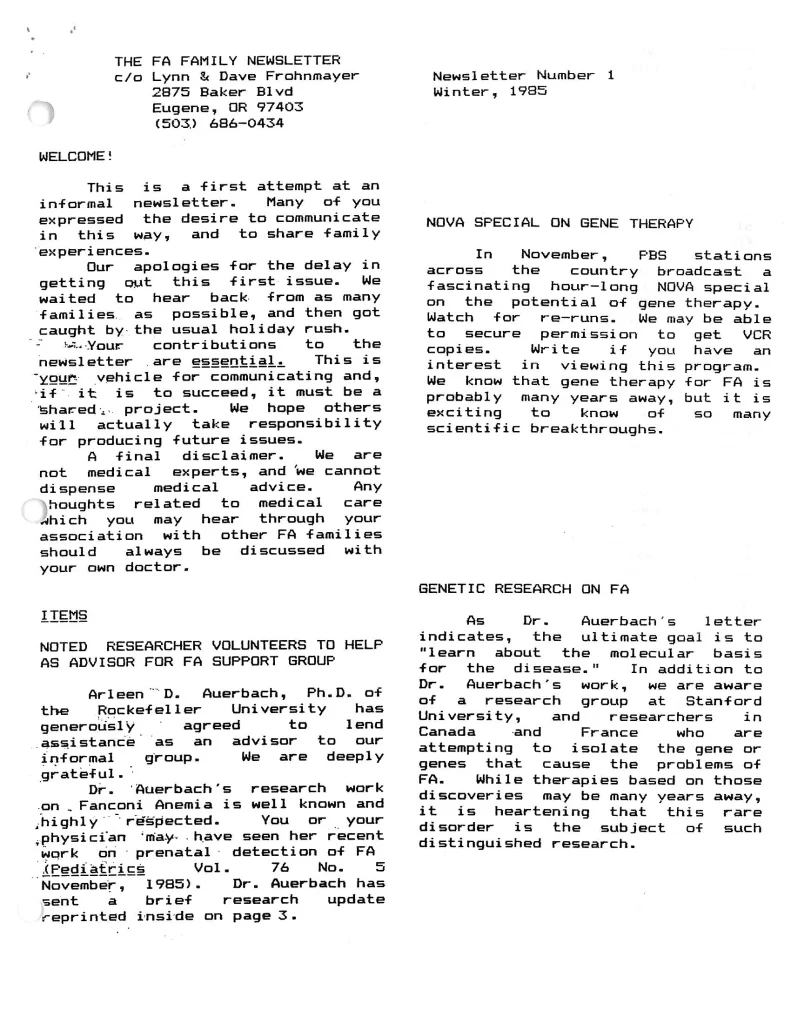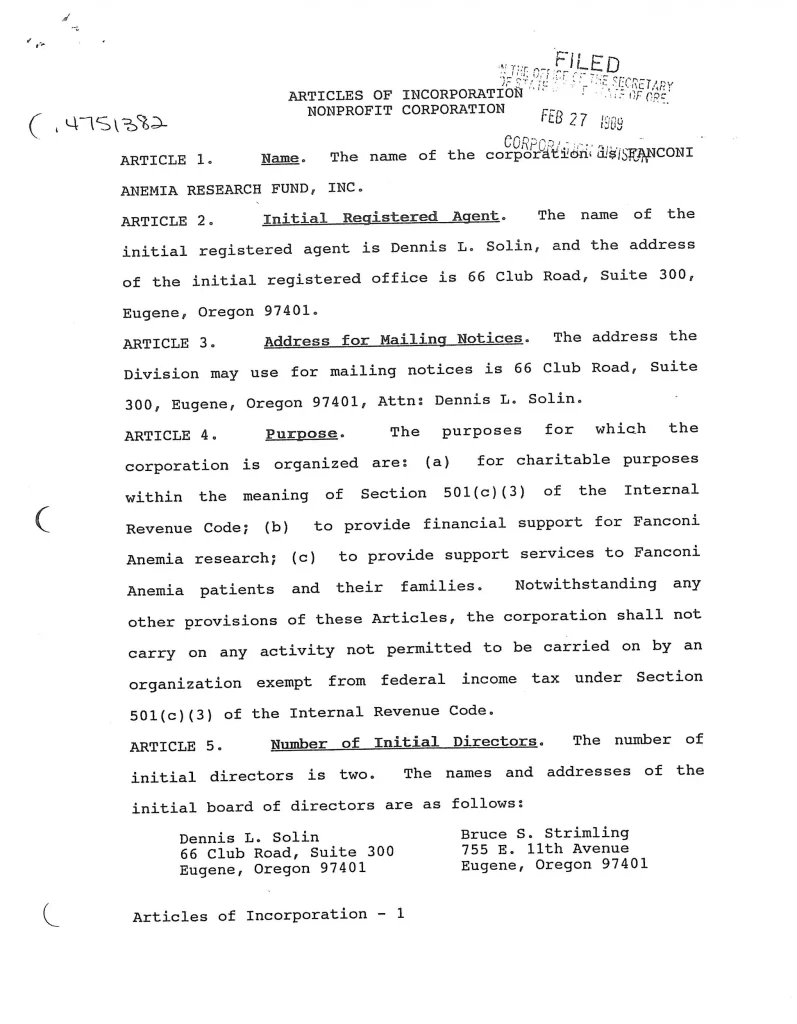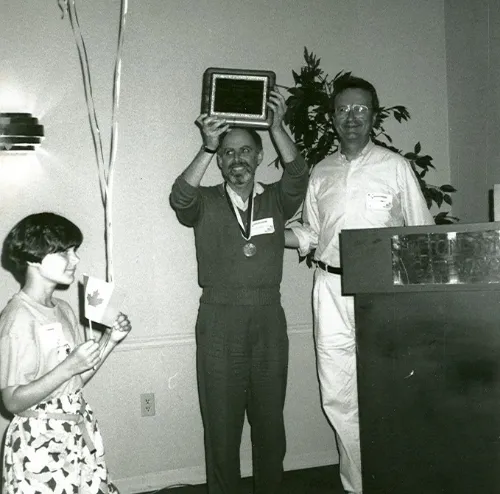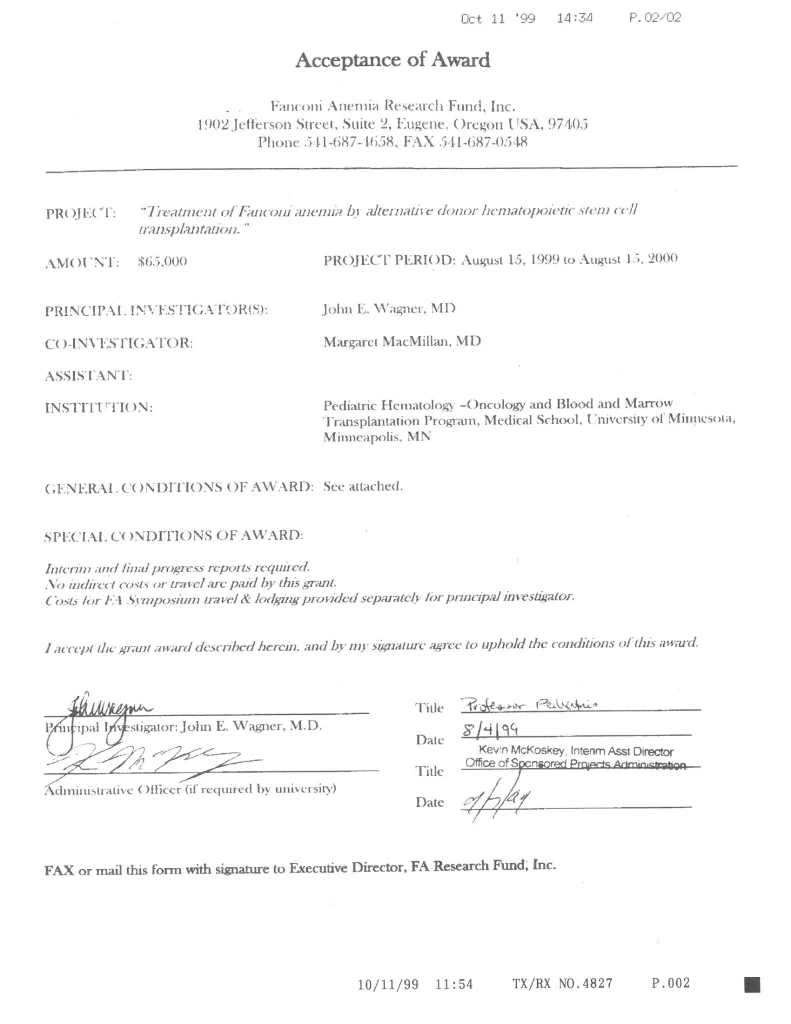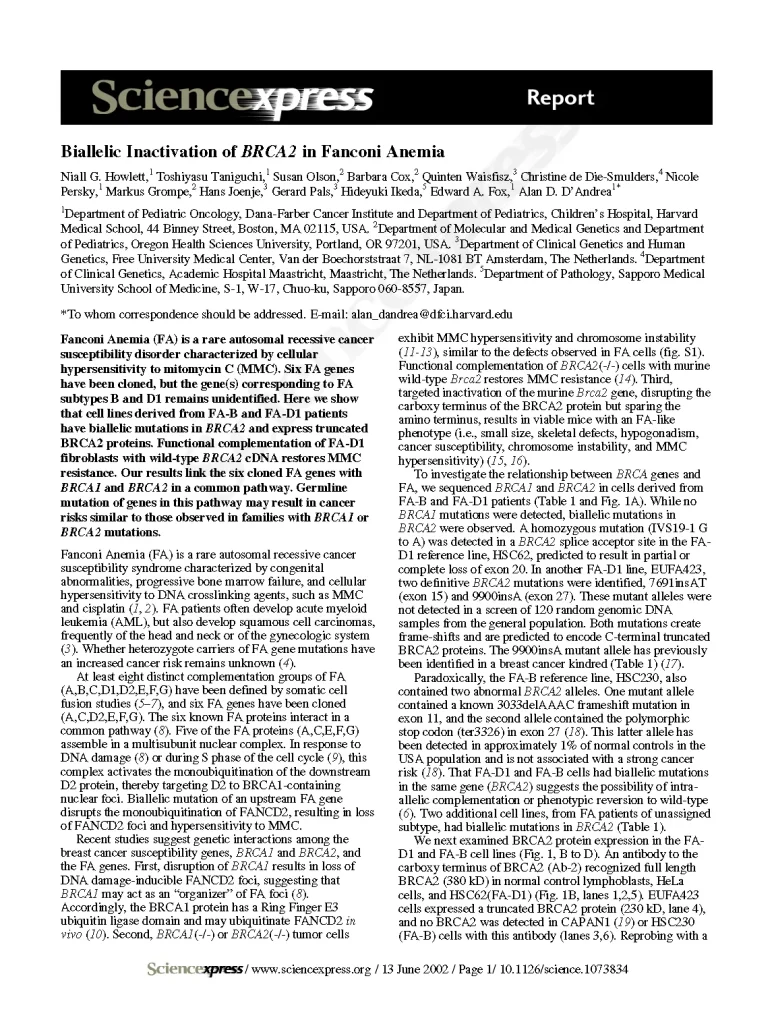Mission & History
Our Mission
At the Fanconi Cancer Foundation (FCF), we are committed to the advancement of FA research in an unwavering pursuit for better treatments, and ultimately a cure, for FA and FA-associated cancers. We offer support, education, and resources to families facing FA to help foster hope across the globe.
As the world leader in the advancement of research for FA, FCF has funded $33 million in research projects and supported more than 260 grants to over 240 scientific investigators worldwide. Founded in 1989 by parents Lynn and David Frohnmayer, FCF strives to create a future that holds promise for those living with and affected by FA and FA-associated cancers.
Our mission is to improve the lives of people affected by Fanconi anemia and associated cancers worldwide by funding exceptional research and empowering our community.
Our History
A Devastating Diagnosis
1983
Oregon parents Lynn and David Frohnmayer learn their two daughters, Kirsten and Katie, have Fanconi anemia (FA), a rare genetic disorder that leads to bone marrow failure, leukemia, and cancer. They would later find out that their third daughter, Amy, also has the disease. The Frohnmayers learn that patients with FA rarely live to adulthood and that there is no cure for this illness. They also discover that the disease is scarcely known in the medical community.

The Frohnmayer family
Early Outreach to Families and Experts
1985
Feeling anxious, frightened and lonely, the Frohnmayers follow the advice of a researcher at The Rockefeller University and reach out to other FA families to create a support group. Nineteen families respond with interest. Lynn and Dave begin writing the FA Family Newsletter to share information they glean from scientists with other families.
1988
A scientist at Rockefeller asks the Frohnmayers to raise $50,000 for research. They promptly write to family, friends, and acquaintances to solicit donations to The Rockefeller University. The unofficial ‘research fund’ is born.
The “Accidental Organization”
1989
A year later, three institutions approach the Frohnmayers to raise money for their investigations. Lynn and Dave again write to their friends and ask them to make checks out to “Fanconi Anemia Research Fund”. However, the institutions can’t cash them as written! The Frohnmayers quickly decide to form a 501(c)(3) charitable corporation, name it the Fanconi Anemia Research Fund (FARF), form a board of directors, and establish articles of incorporation. They cash the checks, send each of the researchers $30,000, and the FA Research Fund is launched!
Humble Beginnings
1989
One of the first steps of the newly formed FA Research Fund is to bring researchers together for a brainstorming session. The Frohnmayers invite scientists who have published about FA or are recommended by those scientists. Eighteen researchers are asked to “bring their brains” to Portland, Ore., where, together with the Frohnmayers and FARF board, they draft what would become FARF’s guiding principles. These same principles continue to define the Fund’s work today: encourage scientific collaboration and a multidisciplinary approach, hold annual scientific symposia, identify and support the best science possible, and fund researchers who would go on to leverage FARF’s start-up grants into much larger grants from their institutions or government entities. The group endorses a five-year Gene Identification Project with the goal of identifying one or more genes responsible for this disorder.
1991
As a scientific community begins to take shape, the Frohnmayers also focus on family engagement as a central strategy. Although at first skeptical that families would be interested or able to gather together, in 1991 more than 100 FA parents and children attend the very first “FA Family Symposium” in Washington, D.C. This gathering marks the beginning of what would become a cornerstone of the FA community: an annual meeting of individuals with FA, their families, and physicians and researchers, with the purpose of educating and supporting families, forming connections and improving and extending the lives of those affected by FA.
1992
One of the first efforts of FARF is to identify the FA gene(s). Gene discovery enables scientists to study and begin to understand the function of the protein(s) encoded by FA gene(s), which might suggest how best to treat the disorder. In 1992, Manuel Buchwald and his team at the Hospital for Sick Children in Toronto, Canada, discover the first FA gene. This is a major breakthrough for FA science and paves the way for many more research discoveries in the decades to follow!
Moving Forward
The 1990s
FARF surges forward in the 90s, funding new research grants each year and expanding family support services. Annual science and family meetings result in the growth of the FA community, consisting of researchers, clinicians, people with FA and their families, volunteers and staff. Educational resources and publications like the patient handbook and family & scientific newsletters keep the community informed and engaged. In 1999, FARF publishes the first edition of Fanconi Anemia: Standards for Clinical Care.
A Game-Changing Discovery
1999
FARF awards the University of Minnesota a grant to determine if one drug, fludarabine, can improve bone marrow transplant outcomes. Almost immediately, success rates go from 20% to 60%. Today, at any one of the three FA comprehensive care centers, more than 90% of young patients survive transplant!
Cancer Connection
2002
In June 2002, researchers discover that BRCA2, one of the breast cancer genes, is also an FA gene. This discovery supports the belief that the primary defect in FA is the inability to repair DNA damage, and is consistent with the finding that those with FA are at far greater risk for cancer. This cancer connection puts FA on the radar of oncologists around the world.
Growth Continues
The 2000s
Throughout the 2000s, FARF continues to extend its outreach, funding several research projects each year, welcoming more scientists and families to regular meetings, and publishing newsletters and family directories. During this decade FARF sponsors seven regional family meetings in addition to the annual FA Family Meeting at Camp Sunshine. In addition to the annual Scientific Symposium, FARF holds nine focused workshops on topics such as bone marrow transplantation, small molecules as possible therapeutics, and squamous cell carcinoma.
In 2003, FARF publishes the second edition of Fanconi Anemia: Standards for Clinical Care. In 2009, the third edition of Fanconi Anemia: Guidelines for Diagnosis and Management is published and distributed around the world. In 2014, this instrumental resource is updated once again and has now been translated into French, Italian and Korean.
Over the years, our dedicated scientists continue to discover new FA genes. As of 2017, researchers have identified 22 FA genes, helping us better understand the function of FA proteins. In addition to the discovery that BRCA2 is an FA gene, scientists have established that four additional FA genes are also breast cancer susceptibility genes: BRCA1; FANCJ/BRIP1; FANCN/PALB2 and FANCO/RAD51C.
Beginning in 2010, FARF enters a partnership with Fanconi Hope, United Kingdom, to expedite gene therapy trials through the creation of the International FA Gene Therapy Working Group. This group meets annually to share expertise and initiate gene therapy clinical trials. Two trials (Seattle and Madrid) have accrued patients and continue to improve protocols.
A Record-Breaking Year
2015
Longtime FARF supporters Phil and Penny Knight pledge $10 million to advance research over the next 10 years. Their incredible gift focuses on bold initiatives to prevent and cure the cancers that affect the adult FA population.
Stepping It Up
2016
After years dedicated to gene identification, improving bone marrow transplantation, and uncovering connections to breast and other cancers, FA scientists are now poised to create less toxic therapies and improve and extend lives. FARF expands focus on the prevention and early detection of cancer. The mission is to improve the clinical outcomes of people with FA and to do so as fast as possible.
2018
Gene therapy trials opened on two continents, and two new clinical trials were approved in early 2018, one of metformin (Dana Farber Cancer Research Center) and the other of quercetin (Cincinnati Children’s Hospital).

Lynn Frohnmayer with Phil Knight
2020
After 14 years of study, FARF-funded researchers proved that examination of the oral cavity combined with painless brush biopsies of identified oral lesions is anaccurate and reliable way to detect oral pre-malignant and malignant lesions. This is a powerful additional step in preventing and detecting oral cancer in a less invasive way for in individuals with FA.
2021
FARF turns a major focus to cancer research, partnering with Stand Up to Cancer, the Farrah Fawcett Foundation, Head and Neck Cancer Alliance, and the American Society of Head and Neck Cancer to fund a three-year, $3.25 million collaborative project. The team is concentrating on new approaches to address head and neck squamous cell carcinoma, with an emphasis on cancers related to the human papillomavirus (HPV) and Fanconi anemia.
In addition, the Joel Walker Cancer Ideas Lab led to a $500,000 collaborative project to develop preclinical models, which will help researchers better understand and address aggressive FA cancers.
2022
FARF forms and funds the Fanconi Anemia Cancer Consortium (FACC), a first of its kind comprehensive clinical research program for preventing, detecting, and treating FA cancer. The FACC is a collaborative partnership between the FA community and a network of clinicians and physician scientists who have expertise in the diagnosis and management of FA cancers and FA cancer research. The first sites to join the global consortium include the National Institutes of Health (the clinical coordinating center for the FACC), the University of Düsseldorf, The Rockefeller University, and British Columbia (BC) Cancer (BC Cancer is funded in partnership with Fanconi Canada).
2023
FARF completes a new strategic plan for 2023-2027 focused on expanding FA cancer research, developing a patient advocacy program, and increasing collaboration with FA clinicians, researchers, and adults with FA.
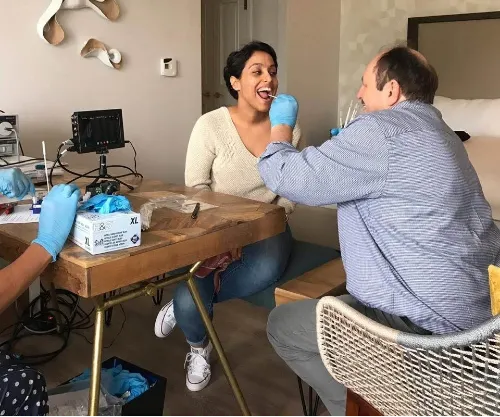
Ralf Dietrich (FA German Family Support Group) takes a sample from Alejandra at the FA Adult Meeting
2024
The Fanconi Anemia Research Fund officially becomes the Fanconi Cancer Foundation (FCF) in a renewed effort to address the most pressing, unsolved issue faced by people with FA: cancer.
While expanding research into the prevention and treatment of cancer, FCF also funds the first International FA Gene Therapy Consortium, comprised of seven world-leading experts in gene therapy and gene editing.

Members of FCF leadership: the Board of Directors, Adult Council, and Scientific Advisory Board.


